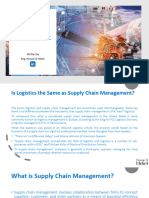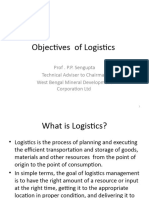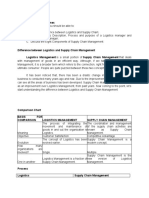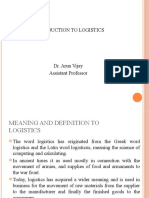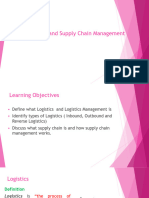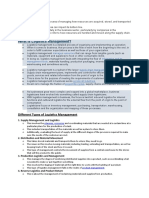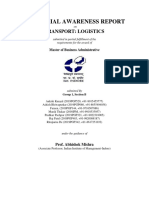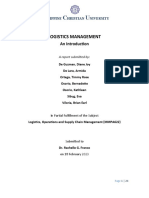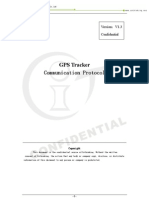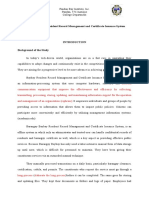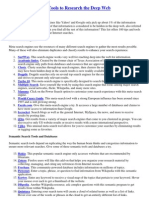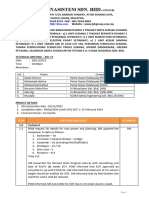LSCM 3rd Sem Module 1
Uploaded by
chandanachar139LSCM 3rd Sem Module 1
Uploaded by
chandanachar139Logistics and Supply Chain Management 22MBA31
Module - 1
Introduction to Logistics Management
Introduction to Logistics Management: Meaning of Logistics, Definition of Logistics, Objectives
of Logistics, Types of Logistics, Need for Logistics Management, Evolution of logistics toward
Supply chain Management, Logistics Industry in India. Logistical Activities, Logistics Costs,
Expected cost of stock outs. Logistical Informational Requirements.
Introduction to Logistics:
Logistics is a critical field of business and operations management that involves the planning,
implementation, and control of the flow of goods, services, information, and resources from their
point of origin to their destination. It plays a fundamental role in ensuring the efficient and cost-
effective movement of products and services throughout the supply chain, ultimately contributing
to the success of businesses and economies.
What Is Logistics?
Logistics refers to the overall process of managing how resources are acquired, stored, and
transported to their final destination. Logistics management involves identifying prospective
distributors and suppliers and determining their effectiveness and accessibility. Logistics managers
are referred to as logisticians.
Logistics Management is simply the movement of things in between the point of origin and point
of final consumption. It is a term concerned with the formulation of plans, management, and
implementation of processes related to the movement and storage of goods.
Logistics refers to the process of planning, implementing, and controlling the efficient and
effective flow of goods, services, and related information from the point of origin to the point of
consumption. It involves the coordination of various activities such as transportation, warehousing,
Asst. Prof. Chandana TC
Department of Management Studies
Sai Vidya Institute of Technology Page 1
Logistics and Supply Chain Management 22MBA31
inventory management, packaging, and order fulfillment to ensure the smooth movement of
products throughout the supply chain.
The primary goal of logistics is to optimize the flow of goods and information, minimize costs,
and meet customer demands in a timely manner. It plays a critical role in supporting the overall
supply chain operations and encompasses both physical and informational aspects.
Definition of Logistics
Logistics is the overall process of managing how resources are acquired, stored, and transported
to their final destination. Poor logistics in a business can impact its bottom line.
Objectives of Logistics
Logistics is a critical component of supply chain management that involves the planning,
implementation, and control of the efficient movement and storage of goods, services, and related
information from the point of origin to the point of consumption. The primary objectives of
logistics are to ensure the smooth and cost-effective flow of goods and information throughout the
supply chain. Here are some key objectives of logistics:
1. Customer Satisfaction: Meeting customer demands and expectations is a fundamental
objective. Logistics aims to ensure that products are available in the right quantity, at the
right time, and in the right condition to meet customer needs.
2. Efficient Transportation: Logistics aims to optimize transportation networks to minimize
costs and delivery times. This involves selecting the most suitable modes of transportation,
routing, and scheduling to ensure timely and cost-effective delivery.
3. Inventory Management: Balancing inventory levels is crucial to prevent stock outs and
excess inventory. Effective logistics involves managing inventory efficiently to meet
customer demand while minimizing carrying costs.
4. Cost Optimization: Logistics seeks to reduce overall supply chain costs while maintaining
service levels. This involves streamlining processes, negotiating favorable transportation
rates, optimizing inventory levels, and minimizing order cycle times.
5. Information Flow: Timely and accurate information is crucial in logistics. The objective
is to establish effective communication and information systems to enhance coordination
and decision-making across the supply chain.
6. Flexibility and Responsiveness: Logistics systems should be flexible enough to adapt to
changes in demand, supply, and market conditions. This includes the ability to quickly
adjust transportation routes, change inventory levels, and adapt to unexpected disruptions.
7. Risk Management: Identifying and mitigating risks is an important logistics objective.
This involves assessing potential risks in the supply chain and developing strategies to
minimize the impact of disruptions, such as natural disasters, geopolitical events, or supply
chain disruptions.
Asst. Prof. Chandana TC
Department of Management Studies
Sai Vidya Institute of Technology Page 2
Logistics and Supply Chain Management 22MBA31
8. Sustainability: With increasing emphasis on environmental responsibility, logistics aims
to minimize its environmental impact. This includes optimizing transportation routes to
reduce emissions, implementing green packaging practices, and adopting sustainable
supply chain practices.
9. Collaboration and Integration: Logistics aims to enhance collaboration and integration
among various stakeholders in the supply chain, including suppliers, manufacturers,
distributors, and retailers. This helps in creating a seamless flow of goods and information.
10. Quality Management: Logistics contributes to maintaining product quality throughout the
supply chain. This involves ensuring that products are handled and transported in a manner
that preserves their integrity and meets quality standards.
Types of Logistics
1. Inbound Logistics
Inbound logistics comprises the transportation, storage, and receiving of goods into a business. It
is the movement of resources from suppliers to manufacturers. It is the first and most important
step in the logistics value chain, as it can impact the remaining processes.
2. Outbound Logistics
Outbound logistics involves transporting semi-finished/finished products to customers from a
warehouse or distribution center. It comprises various stages like warehousing, storage,
distribution, transportation, and last-mile delivery. Outbound logistics’ primary objective is better
customer satisfaction.
Asst. Prof. Chandana TC
Department of Management Studies
Sai Vidya Institute of Technology Page 3
Logistics and Supply Chain Management 22MBA31
3. Reverse Logistics
Reverse logistics is transporting products from the end-users back to the warehouse or distribution
center. It is associated with returns and recalls but is also used for recycling programs, asset
recovery, and disposal.
4. Green Logistics
Green logistics describes measuring and minimizing the environmental impact of supply chain
activities on the planet. It needs to be implemented without compromising on the quality of
services and customer satisfaction.
5. Third-party Logistics
Third-party logistics (3PL) refers to the outsourcing of logistics and supply chain management
functions to a third-party provider. Companies that engage in 3PL services leverage the expertise
and resources of these external providers to handle various aspects of their supply chain, allowing
them to focus on their core business activities.
6. Fourth-party Logistics
Fourth-party logistics (4PL) is an extension of the concept of third-party logistics (3PL) with a
broader scope and more strategic involvement in supply chain management. While a 3PL provider
typically focuses on specific logistics functions, a 4PL provider takes on a more comprehensive
and integrated role in managing an entire supply chain.
7. Digital Logistics
Digital logistics refers to the application of digital technologies and data-driven solutions to
enhance and optimize various aspects of logistics and supply chain management. It involves the
use of advanced technologies to improve the efficiency, visibility, and overall performance of the
logistics processes.
Extras on Logistics
1. Logistics is a part of supply chain management that deals with the efficient forward and
reverse flow of goods, services, and related information from the point of origin to the point
of consumption according to the needs of customers.
2. In military logistics, it is concerned with maintaining army supply lines with food,
armaments, ammunitions, and spare parts apart from the transportation of troops
themselves.
Asst. Prof. Chandana TC
Department of Management Studies
Sai Vidya Institute of Technology Page 4
Logistics and Supply Chain Management 22MBA31
Need for Logistics Management
Logistics management is essential for several reasons, and it plays a
critical role in the success and efficiency of supply chain operations. Here are some key reasons
highlighting the need for logistics management:
1.Cost Efficiency: Logistics management helps optimize the flow of goods and services, reducing
transportation costs, minimizing inventory holding costs, and improving overall cost efficiency.
2.Customer Satisfaction: Timely and accurate delivery of products is essential for meeting
customer expectations. Effective logistics management ensures that products are delivered to
customers on time and in the right condition, enhancing customer satisfaction and loyalty.
3.Market Expansion: Logistics management facilitates market expansion by ensuring that
products are available in different geographical locations. This is essential for reaching new
customers, entering new markets, and increasing market share.
4.Inventory Optimization: Efficient logistics management helps in maintaining optimal
inventory levels. This involves minimizing excess inventory, reducing carrying costs, and
preventing stock outs, thereby ensuring a healthy balance between supply and demand.
5.Supply Chain Visibility: Logistics management provides visibility into the entire supply chain.
This visibility allows businesses to track the movement of goods, monitor inventory levels, and
identify potential bottlenecks or disruptions, enabling proactive decision-making.
6.Risk Management: Effective logistics management helps in identifying and mitigating risks
associated with the supply chain. This includes risks related to transportation, natural disasters,
geopolitical events, and other factors that can impact the flow of goods.
7.Competitive Advantage: Well-executed logistics management can provide a competitive
advantage. Companies that can deliver products faster, more reliably, and at lower costs are better
positioned in the market.
8.Environmental Sustainability: Sustainable logistics practices, such as optimizing
transportation routes and reducing emissions, contribute to environmental responsibility. Logistics
management can play a role in achieving environmentally friendly and socially responsible supply
chain practices.
Asst. Prof. Chandana TC
Department of Management Studies
Sai Vidya Institute of Technology Page 5
Logistics and Supply Chain Management 22MBA31
Evolution of logistics toward Supply Chain Management
The evolution of logistics has been a dynamic process shaped by technological advancements,
globalization, changing consumer expectations, and the need for businesses to operate more
efficiently. The evolution can be broadly categorized into several key phases
1. Pre-Industrial Revolution:
In the pre-industrial era, logistics was rudimentary, mainly involving manual labour and basic
transportation methods. Localized economies meant that supply chains were limited in scope.
2. 3Industrial Revolution (18th-19th centuries):
The Industrial Revolution marked a significant shift in logistics. The introduction of steam-
powered transportation, like trains and steamships, revolutionized the movement of goods over
long distances. Mass production and the rise of factories increased the complexity of supply chains.
3. Early 20th Century
The early 20th century saw the emergence of motorized transportation, particularly trucks, which
provided more flexibility for the movement of goods. Standardized shipping containers began to
gain traction, simplifying loading and unloading processes.
4. Mid-20th Century:
The mid-20th century witnessed the widespread adoption of containerization. The standardization
of container sizes and the development of container ships transformed global trade, making it more
efficient and cost-effective.
5. Late 20th Century:
The late 20th century saw the integration of information technology into logistics. Computers and
software applications facilitated better inventory management, order processing, and overall
supply chain coordination. This period also witnessed the rise of third-party logistics (3PL)
providers.
6. Late 20th to Early 21st Century:
The late 20th and early 21st centuries were characterized by further advancements in technology,
including the use of barcoding, RFID (Radio-Frequency Identification), and GPS for improved
tracking and visibility in logistics. E-commerce began to reshape retail and logistics with the rise
of online shopping.
7. 21st Century:
The 21st century has seen a continued focus on technology integration in logistics. Automation,
robotics, artificial intelligence, and machine learning have been applied to various logistics
functions, such as warehouse operations, route optimization, and demand forecasting.
Asst. Prof. Chandana TC
Department of Management Studies
Sai Vidya Institute of Technology Page 6
Logistics and Supply Chain Management 22MBA31
8. E-commerce and Last-Mile Delivery:
With the exponential growth of e-commerce, last-mile delivery has become a critical focus.
Logistics providers are adapting to meet the demands of quick and reliable delivery to end
consumers, leading to innovations like autonomous vehicles and drones.
9. Sustainability and Green Logistics:
In response to environmental concerns, there is a growing emphasis on sustainability in logistics.
Companies are adopting eco-friendly practices, such as optimizing transportation routes to reduce
carbon emissions and implementing green packaging solutions.
10. Block chain and Digital Supply Chains:
The rise of block chain technology has introduced new possibilities for transparency and
traceability in supply chains. Digital supply chain platforms are being developed to enhance
collaboration, reduce paperwork, and provide real-time information sharing.
The evolution of logistics continues as businesses seek to adapt to emerging technologies,
environmental considerations, and changes in consumer behaviour. As we move forward, logistics
is likely to become even more interconnected, automated, and responsive to the demands of a
rapidly changing global marketplace.
(Or)
Evolution of logistics toward Supply Chain Management
• 1950s & 1960s: U.S. manufacturers focused on mass production techniques as their
principal cost reduction and productivity improvement strategies.
• 1960s to 1970s: Introduction of new computer technology lead to development of
Materials Requirements Planning (MRP) AND Manufacturing Resource Planning (MRP
II) to coordinate inventory management and improve internal communication.
Asst. Prof. Chandana TC
Department of Management Studies
Sai Vidya Institute of Technology Page 7
Logistics and Supply Chain Management 22MBA31
• 1980s & 1990s: Intense global competition led U.S. manufacturers to adopt Supply Chain
Management along with Just-In-Time (JIT), Total Quality Management (TQM) &
Business Process Reengineering (BPR) practices.
• 2000s & Beyond: Industrial buyers will rely more on third-party service providers (3PLs)
to improve purchasing and supply management. Wholesalers/ retailers will focus on
transportation and logistics more and refer to these as quick response, service response
logistics, and integrated logistics.
Logistics Industry in India
In today’s world Logistics is considered as the backbone of an economy. Being the fastest
evolving industry, the Indian logistics sector is currently growing at a rate of 10.5% CAGR since
2017 and estimated to be of $215 Bn by the end of 2020.
The sector in India employs more than 22 million people and has been ranked 44th in the World
Bank’s logistics performance index in 2018 which was 54th in 2014. The Government of India in
the year 2017 awarded this sector with the ‘Infrastructure Status’ to facilitate this significant
industry attract more funding at competitive rates.
The Indian logistics at present is dominated by the transportation sector with over 85 percent
share in terms of value and is expected to remain high for the next few years. The rest is held by
the storage sector. The industry also comes with its unique challenges in India like:
The industry is fragmented owing to the presence of numerous unorganized players. Only
10 percent of the total market share is owned by organized players.
Infrastructure and road connectivity is a challenge in India often identified with slew of
regulatory hurdles.
Storage is a concern with limited material handling methods, fragmented warehousing, and
insufficient infrastructure to store perishable products.
In the year 2022, the size of the Indian logistics market was around 274 billion U.S. dollar.
It was estimated that this market would grow to 563 billion dollars in 2030, at a compound
annual growth rate 9.4 percent.
Road Transport in India:
• The total length of national highways across the south Asian country was over 140 thousand
kilometers in financial year 2022.
• There are over 200 national highways in the nation which control about 40 percent of the road
traffic.
Asst. Prof. Chandana TC
Department of Management Studies
Sai Vidya Institute of Technology Page 8
Logistics and Supply Chain Management 22MBA31
• The highways, however, make up a share of less than two percent of all Indian roads.
• The National Highway Authority of India is responsible for the maintenance and new
construction of the country’s highway network.
Railways in India:
• The Indian railway network is the third largest in the world.
• With focused attention from the government and investments in improving infrastructure, the
railway sector is recognized as one of the largest railway systems under single management.
• Apart from carrying over ten thousand passengers per day, more than seven thousand freight
trains play their part in carrying over three million metric tons of freight per day.
• In financial year 2022, the average freight rate per metric ton across the country was 1.6 Indian
rupees per kilometer.
Air Freight in India:
• The total freight tonnage handled at Indian airports in financial year 2022 was at 3.14 million
metric tons.
• The majority of this was international freight.
• Three major airports, namely Indira Gandhi International Airport in Delhi, Chhatrapati Shivaji
International Airport in Mumbai, and Kempe Gowda International Airport in Bengaluru, handled
nearly half of the air freight of the country.
Ocean Transport in India:
• Ever since its independence, India’s shipping industry has registered remarkable growth.
• In fiscal year 2019, India had over 1.4 thousand vessels registered under its flag.
• In financial year 2021, the total number of ports across India stood at 224.
• There was an increase in the number of ports across the south Asian country after five years in
2019.
• Seven new non-major ports were added to the list.
• In 2021, the country had 12 major and 212 non-major ports.
• The role of the maritime transport sector in attracting investments and creating employment in
the Indian economy is irrefutable.
• As much as three-fourth of the country’s trade value is handled through maritime transport.
Recent trends show interesting opportunities in regard to the Indian logistics sector in the
coming years. Few of them are:
● In recent years, Tier-II and III cities have witnessed a growth in consumption patterns, resulting
in a focus-shift towards logistics.
●Artificial Intelligence has been imperative in saving time, reducing costs, increasing productivity,
and accuracy with cognitive automation.
Asst. Prof. Chandana TC
Department of Management Studies
Sai Vidya Institute of Technology Page 9
Logistics and Supply Chain Management 22MBA31
● Exports in India are on a rising tide with 2018-19 reaching record high registering an expansion
of around 11%.
The Prime Minister of India at his address during the 1st phase of lockdown has mentioned about
logistics sector as ‘essential’. This sector is also among the few permitted to operate with minimum
workforce during complete lockdown. Logistics is an all-time essential sector from ensuring
essential supplies to commencement of international trade. Strengthening and expansion of this
sector will ensure a better tomorrow.
ICC has taken several initiatives in the logistics and supply chain domain on Policy,
business development, thought leadership and events etc.
ICC National Expert Committee closely works with policy makers at National and State
level
with the active support from Industry Players.
Logistics & Supply Chain sector is headed by Ms. Paromita Bhowmick Chaki.
(Or)
As of last Update in January 2022, the logistics industry in India has been experiencing significant
growth and transformation. As of my last update, here are some key aspects of the logistics industry
in India:
Size and Contribution to GDP: The logistics sector is a crucial component of India's
economy, contributing significantly to its Gross Domestic Product (GDP). It plays a vital
role in facilitating trade, connecting various regions, and supporting industries.
Growth Factors: The industry has been witnessing robust growth due to factors such as
increasing e-commerce activities, government initiatives like "Make in India" and "Goods
and Services Tax" (GST) implementation, which has streamlined the movement of goods
across state borders.
E-commerce Boom: The rapid growth of e-commerce platforms has been a major driver
for the logistics sector. E-commerce companies heavily depend on efficient and reliable
logistics for order fulfilment, last-mile delivery, and returns management.
Infrastructure Development: Ongoing infrastructure development projects, including the
construction of expressways, logistics parks, and improved connectivity, have positively
impacted the logistics sector. These developments aim to enhance transportation efficiency
and reduce transit times.
Technology Adoption: There has been an increased focus on technology adoption within
the logistics industry. Companies are leveraging technologies such as GPS tracking,
warehouse management systems, and data analytics to enhance operational efficiency and
provide better visibility across the supply chain.
Asst. Prof. Chandana TC
Department of Management Studies
Sai Vidya Institute of Technology Page 10
Logistics and Supply Chain Management 22MBA31
Challenges: The industry faces challenges such as inadequate infrastructure in certain
regions, complex regulatory frameworks, and a need for more skilled labour. Addressing
these challenges is crucial for sustaining the momentum of growth.
Multimodal Transportation: To improve efficiency, the industry is increasingly adopting
multimodal transportation, integrating road, rail, air, and sea routes. This approach helps
optimize logistics routes based on the nature of goods and distance to be covered.
Government Initiatives: The Indian government has been actively promoting initiatives
to boost the logistics sector. Infrastructure projects, policy reforms, and efforts to simplify
regulations aim to create a more favourable environment for logistics operations.
Start-ups and Innovation: The logistics sector in India has witnessed the emergence of
numerous start-ups focused on solving specific challenges within the supply chain. These
start-ups often bring innovative solutions, leveraging technology to address inefficiencies.
Global Logistics Hub Ambitions: India aspires to become a global logistics hub. This
involves not only domestic improvements but also positioning the country as a preferred
logistics partner for international trade.
It's important to note that the logistics industry is dynamic and subject to changes based on
economic, technological, and regulatory developments. For the latest and most accurate
information, it's recommended to refer to recent reports, industry analyses, and news updates.
Logistical Activities
Logistical activities encompass a wide range of functions that collectively ensure the efficient and
effective flow of goods, services, and information throughout the supply chain. These activities
are integral to logistics and supply chain management, contributing to the overall success and
competitiveness of businesses. Here are some key logistical activities:
Asst. Prof. Chandana TC
Department of Management Studies
Sai Vidya Institute of Technology Page 11
Logistics and Supply Chain Management 22MBA31
1. Processing Orders
A critical part of logistics functions is order processing. There are various ways to submit an order,
such as through mail, telephone, salespeople, or computers. However, orders must be processed as
soon as they are received. Business organizations and customers both reap the benefits of efficient
order processing. Some major order processing activities include the following:
Checking the order for any changes in negotiated terms.
Payment and delivery terms.
Checking the availability of stock.
Production and material scheduling to cater to shortages.
2. Transportation
Transportation is the most crucial and essential function of logistics in supply chain management
since it allows items to move from the provider to the buyer. When a customer places an order, the
purchase is not complete until the products are physically delivered to their location.
Transportation consumes 60 to 70% of logistics costs, particularly for low unit-priced and mass-
consumed products. Various transportation modes are used to physically move items, such as rail,
truck, water, and air.
Firms select methods of transport based on the state's or area's transportation systems. When
choosing a form of transportation, the most important factor to consider is the price. However, the
necessity of the product at the customer's end might occasionally outweigh the economic issue.
Regardless of the expense, the goods are sent through the fastest route.
3. Managing Inventory
Inventory management is one of the most important logistical functions that is also considered the
worst offender in a company's entire supply chain because of its high carrying cost, which eats
into profits indirectly. It includes costs such as inventory funding, security, warehousing, damages,
repairs, and thefts. Inventory management is all about having enough inventory on hand to meet
customer requirements while keeping carrying costs low. It's a delicate balancing act between
offering exceptional customer service while minimizing market share loss and the associated costs.
4. Warehousing
The storage of finished items until they are delivered is known as warehousing, which is significant
to a company's logistics functions. The right warehousing decisions determine the efficacy of a
company's marketing.
With the recent developments in technology, warehousing has improved significantly. Single-
storied automated warehouses have replaced older multi-storied warehouses with a limited number
of employees.
Asst. Prof. Chandana TC
Department of Management Studies
Sai Vidya Institute of Technology Page 12
Logistics and Supply Chain Management 22MBA31
In logistics, warehousing is a critical decision area. With right and modern warehousing, you can
reduce labor costs and have greater inventory control.
5. Packaging
Packaging is a critical element of logistics management functions. It impacts the effectiveness of
the logistics system by influencing the physical flow of a product. It's not the same as package
design, which is focused on marketing goals.
However, logistical packing is necessary for breakage prevention, handling of materials, and
storage space efficiency. In terms of packing cost, load utilization significantly impacts logistical
packaging.
6. Handling Materials and Storage
Material handling is considered influential among other logistical functions because it affects how
inventory moves along the distribution chain. Product breakage, delivery delays, and incidental
overhead expenses will increase because of incorrect material handling.
Advanced manufacturing technologies and material handling increase the efficiency of the
logistics system. The numbers to be managed, the speed necessary for material transportation, and
the degree of service to customers are all factors to consider when choosing a material handling
system.
The storage system is critical for maximum space utilization in a warehouse of a particular size.
For quick movement (holding and retrieving) of items to and from the warehouse, the supply chain
strategy should work in tandem with the storage system.
7. Monitoring
Businesses must keep inventory control, transport, and warehousing all up to date. Each site needs
to know about its present supply chain situation, future obligations, and restocking capacity
regularly.
These logistical activities are interconnected and require careful planning and coordination to
ensure a seamless and responsive supply chain. Efficient logistics contribute to cost savings,
customer satisfaction, and a competitive advantage in the marketplace.
Asst. Prof. Chandana TC
Department of Management Studies
Sai Vidya Institute of Technology Page 13
Logistics and Supply Chain Management 22MBA31
Logistics Costs
Logistics costs refer to the expenses associated with the planning, implementation, and
management of the flow of goods, services, and information throughout the supply chain. These
costs are incurred at various stages of the logistics process and contribute to the overall cost
structure of a business. Understanding and managing logistics costs are crucial for optimizing
supply chain efficiency and improving the competitiveness of a company. Here are key
components of logistics costs:
Transportation Costs: Expenses related to the movement of goods from one location to
another. This includes costs associated with shipping, freight charges, fuel, maintenance,
and transportation infrastructure.
Warehousing Costs: Costs associated with storing and managing inventory in warehouses.
This includes expenses related to facilities, labor, equipment, security, and utilities.
Inventory Holding Costs: Costs incurred for holding and managing inventory. This
includes expenses related to storage, insurance, taxes, and the opportunity cost of tying up
capital in unsold goods.
Order Processing Costs: Expenses related to the processing of customer orders. This
includes costs associated with order entry, validation, picking, packing, and preparing
orders for shipment.
Packaging Costs: Expenses related to designing, producing, and using packaging
materials for products. Packaging costs include materials, labor, and equipment costs.
Information Technology Costs: Costs associated with the implementation and
maintenance of information technology systems that support logistics operations. This
includes the costs of software, hardware, and technology infrastructure.
Reverse Logistics Costs: Costs associated with managing the return of products from
customers. This includes expenses related to product returns, repairs, recycling, or disposal.
Handling Costs: Costs associated with the physical handling of goods during various
stages of the supply chain. This includes loading and unloading costs, as well as handling
equipment and labor costs.
Customs and Duties: Costs associated with complying with customs regulations and
paying duties on imported or exported goods. These costs can include tariffs, customs
broker fees, and compliance-related expenses.
Asst. Prof. Chandana TC
Department of Management Studies
Sai Vidya Institute of Technology Page 14
Logistics and Supply Chain Management 22MBA31
Risk Management Costs: Expenses related to identifying, assessing, and mitigating risks
in the supply chain. This includes costs associated with insurance, security measures, and
contingency planning.
Sourcing and Procurement Costs: Costs related to the procurement of raw materials or
finished goods. This includes expenses related to sourcing, negotiations, supplier
management, and quality control.
Labor Costs: Costs associated with the labor required for various logistics activities,
including transportation, warehousing, order processing, and inventory management.
Facility Costs: Costs associated with maintaining and operating facilities such as
warehouses, distribution centers, and transportation hubs. This includes rent, utilities,
maintenance, and facility-related expenses.
Managing logistics costs effectively involves optimizing each of these components to achieve a
balance between cost and service levels. Businesses often use logistics cost analysis and modeling
to identify areas for improvement and implement strategies to enhance overall supply chain
efficiency.
Expected cost of stock outs
Stock out costs is the capital lost from inventory that has become unavailable for the customer to
purchase. When a customer cannot buy something because it is not in stock, the business loses
money.
The expected cost of stock outs refers to the anticipated financial impact or losses that a company
may incur when it runs out of stock and is unable to meet customer demand. This cost can vary
based on several factors and may include both direct and indirect costs.
Here are some elements to consider when estimating the expected cost of stock outs:
Lost Sales and Revenue:
• Direct revenue loss occurs when customers are unable to purchase products due to
stock outs.
• Potential long-term revenue impact if customers switch to competitors.
Customer Dissatisfaction:
• Damage to the company's reputation and customer loyalty.
• Potential negative reviews and word-of-mouth publicity.
Asst. Prof. Chandana TC
Department of Management Studies
Sai Vidya Institute of Technology Page 15
Logistics and Supply Chain Management 22MBA31
Expediting Costs:
• Rushing orders to replenish stock quickly, which often incurs higher shipping and
handling costs.
Emergency Production Costs:
• In cases where production needs to be expedited to meet demand, additional
production costs may be incurred.
Substitute Product Costs:
• If a substitute product must be sourced, it may come at a higher cost than the regular
inventory.
Customer Service Costs:
• Increased workload for customer service teams dealing with complaints and
inquiries.
Stock Replenishment Costs:
• Costs associated with restocking inventory, including ordering, receiving, and
handling.
Impact on Future Sales:
• Long-term consequences on customer trust and loyalty, affecting future sales.
Understanding the expected cost of stock outs is crucial for businesses for several reasons
Financial Impact: The direct financial impact of lost sales and revenue due to stock outs can be
substantial. Knowing the expected cost helps companies assess the potential impact on their
bottom line.
Profitability Analysis: Businesses can use the expected cost of stock outs to evaluate the
profitability of different inventory management strategies. This analysis helps in finding the right
balance between stocking enough inventory to meet demand and avoiding overstock situations.
Optimizing Inventory Levels: Knowing the cost of stock outs allows businesses to optimize their
inventory levels. Maintaining the right balance helps minimize stock outs while avoiding excess
holding costs.
Customer Satisfaction and Loyalty: Stock outs can negatively impact customer satisfaction and
loyalty. By understanding the expected cost, businesses can invest in strategies to improve
customer service, minimize stock outs, and maintain a positive customer experience.
Asst. Prof. Chandana TC
Department of Management Studies
Sai Vidya Institute of Technology Page 16
Logistics and Supply Chain Management 22MBA31
Risk Management: Estimating the cost of stock outs helps in risk management. Businesses can
identify potential areas of vulnerability in their supply chain and implement measures to mitigate
the risk of stock outs.
Competitive Advantage: Maintaining optimal inventory levels and minimizing stock outs can
provide a competitive advantage. Understanding the cost of stock outs helps businesses position
themselves favorably in the market by reliably meeting customer demand.
Resource Allocation: Businesses can allocate resources more efficiently by understanding the
cost implications of stock outs. This includes optimizing production schedules, managing
transportation and logistics, and allocating budget resources.
Continuous Improvement: Regularly evaluating the expected cost of stock outs encourages a
culture of continuous improvement. Businesses can use this information to identify areas for
improvement in their supply chain and inventory management processes.
Strategic Decision-Making: The expected cost of stock outs is a critical factor in strategic
decision-making. It influences decisions related to production planning, inventory policies, and
supply chain management.
Logistical Informational Requirements
Logistical informational requirements refer to the data and information that are essential for
effective and efficient logistics management within a supply chain. This information is critical for
making informed decisions, optimizing processes, and ensuring that goods and services move
seamlessly from the point of origin to the point of consumption.
• Demand Forecasting:
Information about anticipated demand for products or services helps in planning inventory levels,
production schedules, and transportation requirements.
• Inventory Levels:
Accurate and up-to-date information about current inventory levels at various locations in the
supply chain is crucial for preventing stock outs or overstock situations.
• Order Status and Tracking:
Real-time information on the status and location of orders helps in monitoring shipments,
managing delivery schedules, and providing customers with accurate delivery estimates.
Asst. Prof. Chandana TC
Department of Management Studies
Sai Vidya Institute of Technology Page 17
Logistics and Supply Chain Management 22MBA31
• Supplier Information:
Details about suppliers, including lead times, production capabilities, and performance metrics,
are essential for making informed decisions about sourcing and procurement.
• Transportation Data:
Information about transportation modes, carriers, routes, and transit times is critical for optimizing
logistics and ensuring timely and cost-effective deliveries.
• Regulatory Compliance:
Information about relevant regulations, customs requirements, and compliance standards is crucial
for ensuring that shipments meet legal and regulatory standards.
• Product Information:
Detailed information about the characteristics, dimensions, weight, and packaging requirements
of products is essential for proper handling and transportation planning.
• Technology and IT Systems:
Information about the technology infrastructure, software systems, and data exchange protocols is
necessary for seamless integration and communication within the supply chain.
• Lead Times:
Accurate lead time information for each stage of the supply chain helps in planning production,
procurement, and delivery schedules.
• Risk Management Data:
Information about potential risks, such as disruptions in supply or transportation, allows for
proactive risk management and contingency planning.
• Cost Data:
Detailed cost information, including transportation costs, handling costs, and inventory carrying
costs, is essential for optimizing logistics processes and managing overall supply chain costs.
• Quality Assurance Data:
Information related to quality control processes, inspection criteria, and standards is crucial for
ensuring that products meet quality requirements throughout the supply chain.
• Collaborative Planning Information:
Collaborative planning and forecasting data shared among supply chain partners help in aligning
strategies, coordinating activities, and improving overall supply chain efficiency.
• Environmental and Sustainability Metrics:
Asst. Prof. Chandana TC
Department of Management Studies
Sai Vidya Institute of Technology Page 18
Logistics and Supply Chain Management 22MBA31
Information on environmental impact and sustainability metrics helps in aligning logistics
processes with environmental goals and ensuring compliance with sustainability initiatives.
• Warehousing Information:
Data on warehouse locations, capacities, and handling capabilities are necessary for efficient
storage, picking, packing, and shipping of goods.
*********
Asst. Prof. Chandana TC
Department of Management Studies
Sai Vidya Institute of Technology Page 19
You might also like
- International Supply Chain and Logistics ManagementNo ratings yetInternational Supply Chain and Logistics Management98 pages
- Logistics and Supply Chain Management Not For Degree StudentNo ratings yetLogistics and Supply Chain Management Not For Degree Student41 pages
- Logistics and Supply Chain Management Not For Degree StudentNo ratings yetLogistics and Supply Chain Management Not For Degree Student38 pages
- Logistics Management Importance Objective Amp Features.No ratings yetLogistics Management Importance Objective Amp Features.3 pages
- Logistics and Supply Chain Management: Unit 1 - Introduction To Logistic ManagementNo ratings yetLogistics and Supply Chain Management: Unit 1 - Introduction To Logistic Management86 pages
- Supply Chain and Logistics Management: Written by Eng. Hassan Al HelielNo ratings yetSupply Chain and Logistics Management: Written by Eng. Hassan Al Heliel46 pages
- MMPO-008 (International Logistics and Supply Chain Management)No ratings yetMMPO-008 (International Logistics and Supply Chain Management)82 pages
- Presentation Inventory and Suply Chain ManagementNo ratings yetPresentation Inventory and Suply Chain Management64 pages
- Introduction To Logistics and Supply Chain ManagementNo ratings yetIntroduction To Logistics and Supply Chain Management12 pages
- Chapter 2 - Overview of Logistics Management - Introduction To Logistics and SCMNo ratings yetChapter 2 - Overview of Logistics Management - Introduction To Logistics and SCM40 pages
- Introduction To Logistics Management PDFNo ratings yetIntroduction To Logistics Management PDF65 pages
- EDR SC On Logistics Managemnet by EyasuNo ratings yetEDR SC On Logistics Managemnet by Eyasu43 pages
- Chapter 2 - Overview of Logistics Management - Introduction To Logistics and SCMNo ratings yetChapter 2 - Overview of Logistics Management - Introduction To Logistics and SCM40 pages
- Introduction To Retail Management Module 1100% (1)Introduction To Retail Management Module 152 pages
- Unit 6 - Logistics & Supply Chain Management - To StsNo ratings yetUnit 6 - Logistics & Supply Chain Management - To Sts50 pages
- 100 Useful Tips and Tools To Research The Deep Web100% (1)100 Useful Tips and Tools To Research The Deep Web5 pages
- Quick Start Guide: Rainwise Cc-2000 EditionNo ratings yetQuick Start Guide: Rainwise Cc-2000 Edition7 pages
- Automic - Automation 24.2.0 2024-10-23 Update-InformationNo ratings yetAutomic - Automation 24.2.0 2024-10-23 Update-Information4 pages
- Operating Instructions and Service Manual Basketball Shotclock MODEL MP-2299No ratings yetOperating Instructions and Service Manual Basketball Shotclock MODEL MP-229920 pages
- AZ 900.examcollection - Premium.exam.186q QxrUryv100% (3)AZ 900.examcollection - Premium.exam.186q QxrUryv150 pages
- (Laboratory Animal Pocket Reference Series) Suckow, Mark A. - Field, Karl J. - Sibold, Amber L-The Laboratory Hamster & Gerbil-CRC Press (1999)No ratings yet(Laboratory Animal Pocket Reference Series) Suckow, Mark A. - Field, Karl J. - Sibold, Amber L-The Laboratory Hamster & Gerbil-CRC Press (1999)170 pages
- 30-11-2024 - SR - Super60 - STERLING-BT - Jee-Main - RPTM-20 - KEY & Sol'SNo ratings yet30-11-2024 - SR - Super60 - STERLING-BT - Jee-Main - RPTM-20 - KEY & Sol'S10 pages
- HSY 2024 Proxy Statement and 2023 Annual ReportNo ratings yetHSY 2024 Proxy Statement and 2023 Annual Report220 pages













